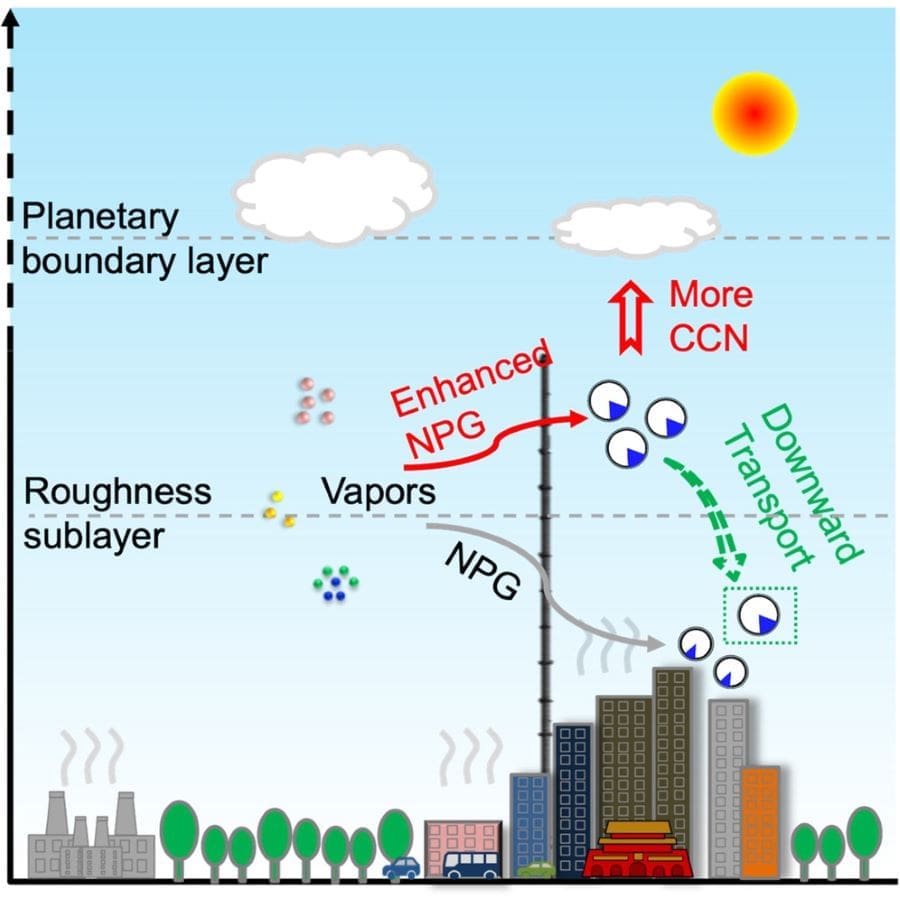Summary:
A study published in One Earth reveals that the climate impact of newly formed atmospheric particles in urban areas has been underestimated by about 20%.
These particles, formed through chemical reactions in the atmosphere, influence cloud formation and local climate regulation. Researchers used a 325-meter meteorological tower in Beijing to analyze particle formation at different heights, finding that it is more pronounced at higher altitudes due to greater sulfuric acid concentrations and increased humidity. The findings challenge traditional ground-level measurements and emphasize the need for vertical observations to fully understand urban aerosol dynamics.
Scientists from the University of Helsinki, the Chinese Academy of Sciences, and other institutions stress that this research has critical implications for climate policy and urban planning, particularly in mitigating air pollution and its broader environmental effects.

We have underrated the climate effects of new particles in urban areas
Particles play a crucial role in climate regulation, influencing processes such as cloud formation and radiation balance. Traditionally, research in urban environments has focused largely on primary particles – those directly emitted from sources like vehicle exhaust and industrial activities – while new particles, which are formed through atmospheric reactions, have often been overlooked in discussions about their climatic impacts.
A recent study has uncovered compelling evidence suggesting that the climate effects of new particles in urban areas have been significantly underestimated.
“To accurately assess the climate effects of particles, we need comprehensive long-term vertical observations,” says Academician Markku Kulmala from the Institute for Atmospheric and Earth System Research INAR at the University of Helsinki. This call for enhanced observational strategies underscores the complexity of atmospheric processes and the importance of capturing data from different heights to better understand urban aerosol behavior.
Enhanced particle formation aloft in urban areas
Utilizing advanced measurement techniques based on a 325-meter meteorological tower in Beijing, the research team analyzed particle formation at various heights above the urban landscape. This study revealed that particle formation is more pronounced at higher altitudes, where factors such as greater concentrations of sulfuric acid and increased relative humidity promote particle growth. This is particularly pertinent in urban environments, where pollution levels and atmospheric dynamics can vary dramatically, leading to different growth mechanisms for new particles compared to rural areas.
“The enhanced particle formation aloft suggests that while ground-level measurements provide valuable insights, they may not caputure the full picture of particle dynamics, particularly in densely populated urban areas,” says Wei Du, a key researcher in the study. This insight highlights the importance of examining the atmosphere above the skyline to understand atmospheric processes in urban environments more comprehensively.
The climate effects of new particles
When gaseous precursors related to anthropogenic emissions are transported to elevated layers of the atmosphere, they enhance the growth of particles, enabling them to become effective cloud condensation nuclei (CCN), which are essential for cloud formation and local climate regulation. The study asserts that the influence of new particles on CCN has been underestimated by approximately 20%. Therefore, understanding the vertical component of urban atmospheric processes is critical for fully grasping the impact of particulate matter on climate.
The implications of this research extend beyond academic discourse and hold significant relevance for policy-making and urban planning.
“As cities continue to grapple with air pollution and climate challenges, understanding the vertical profiles of the atmopsheric processes can help develop more effective strategies to mitigate their impacts on both climate and public health,” Wei says.
The study represents a collaborative effort from researchers at the University of Helsinki, the Chinese Academy of Sciences, and various additional partners.
“The Beijing 325 m Meteorological Tower is a unique research platform for atmospheric and climate science in megacities. We are pleased to collaborate with international partners to address climate change together,” says Yele Sun, Professor at the Chinese Academy of Sciences.
Journal Reference:
Du, Wei et al. ‘Impacts of enhanced new-particle growth events above urban roughness sublayer on cloud condensation nuclei’, One Earth 8, 1, 101169 (2025). DOI: 10.1016/j.oneear.2024.12.005
Article Source:
Press Release/Material by University of Helsinki
Featured image: Researchers performed the state-of-the-art instrumentation at the top of the Beijing Meteorological Tower to investigate the influence of new particles on cloud formation. Credit: Hao Li




